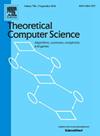Computing the D-base and D-relation in finite closure systems
IF 1
4区 计算机科学
Q3 COMPUTER SCIENCE, THEORY & METHODS
引用次数: 0
Abstract
Implicational bases (IBs) are a common representation of finite closure systems and lattices, along with meet-irreducible elements. They appear in a wide variety of fields ranging from logic and databases to Knowledge Space Theory.
Different IBs can represent the same closure system. Therefore, several IBs have been studied, such as the canonical and canonical direct bases. In this paper, we investigate the D-base, a refinement of the canonical direct base. It is connected with the D-relation, an essential tool in the study of free lattices. The D-base demonstrates desirable algorithmic properties, and together with the D-relation, it conveys essential properties of the underlying closure system. Hence, computing the D-base and the D-relation of a closure system from another representation is crucial to enjoy its benefits. However, complexity results for this task are lacking.
In this paper, we give algorithms and hardness results for the computation of the D-base and D-relation. Specifically, we establish the NP-completeness of finding the D-relation from an arbitrary IB; we give an output-quasi-polynomial time algorithm to compute the D-base from meet-irreducible elements; and we obtain a polynomial-delay algorithm computing the D-base from an arbitrary IB. These results complete the picture regarding the complexity of identifying the D-base and D-relation of a closure system.
有限闭包系统中d基和d关系的计算
隐含基(ib)是有限闭包系统和格的常见表示,以及满足不可约元素。它们出现在从逻辑学、数据库到知识空间理论的各个领域。不同的ib可以表示相同的闭包系统。因此,研究了几种ibb,如规范和规范直接碱。本文研究了典型直基的一种改进——d基。它与d关系有关,d关系是研究自由晶格的一个重要工具。d基展示了理想的算法属性,并与d关系一起传达了底层闭包系统的基本属性。因此,从另一种表示计算闭包系统的d基和d关系对于享受其好处至关重要。然而,缺乏此任务的复杂性结果。本文给出了d基和d关系计算的算法和硬度结果。具体地说,我们建立了从任意IB寻找d关系的np完备性;给出了一种输出拟多项式时间算法来计算满足不可约元素的d基;我们得到了一个从任意IB计算d基的多项式延迟算法。这些结果完成了关于识别闭包系统的d基和d关系的复杂性的图片。
本文章由计算机程序翻译,如有差异,请以英文原文为准。
求助全文
约1分钟内获得全文
求助全文
来源期刊

Theoretical Computer Science
工程技术-计算机:理论方法
CiteScore
2.60
自引率
18.20%
发文量
471
审稿时长
12.6 months
期刊介绍:
Theoretical Computer Science is mathematical and abstract in spirit, but it derives its motivation from practical and everyday computation. Its aim is to understand the nature of computation and, as a consequence of this understanding, provide more efficient methodologies. All papers introducing or studying mathematical, logic and formal concepts and methods are welcome, provided that their motivation is clearly drawn from the field of computing.
 求助内容:
求助内容: 应助结果提醒方式:
应助结果提醒方式:


